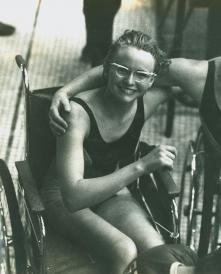 In celebration of the 50th anniversary of the Tokyo 1964 Paralympic Games, three of Australia’s pioneering Paralympians Elizabeth Edmondson, Bill Mather-Brown and Michael Dow reflect on their time in Japan and how far the movement has come in half a century.
In celebration of the 50th anniversary of the Tokyo 1964 Paralympic Games, three of Australia’s pioneering Paralympians Elizabeth Edmondson, Bill Mather-Brown and Michael Dow reflect on their time in Japan and how far the movement has come in half a century.
From 8-12 November 1964, 375 athletes from 21 countries took part in the Tokyo 1964 Paralympic Games – the second Games ever held. With a team made up of 15 athletes, Australia placed fourth on the medals table to bring home 12 gold, 11 silver and 7 bronze medals.
Australia’s main victories were in the pool, where 14-year-old Elizabeth Edmondson won three gold medals to become Australia’s youngest Paralympic gold medallist; a record she held for 48 years.
“When an English man presented me with my medals, he said ‘congratulations, you flaming drongo!’ I didn’t know whether to be insulted or pleased,” Elizabeth recalls.
Even with such an impressive record to her name, Elizabeth says that it is only in retrospect that she can see the significance of her achievements and her part in growing the Paralympic movement in Australia.
“Fifty years ago, I had never heard about the Paralympics until I was selected!” Elizabeth explains.
“At the time I didn’t know how much the movement would grow because not much of a fuss was made. My parents couldn’t come with me and there wasn’t much coverage of what happened,” she said.
In contrast, three-time Paralympian Bill Mather-Brown, who as a journalist reported on Para-sport before taking part in the Stoke Mandeville Games in 1957 and Rome 1960 Paralympic Games, says that the Australian Government made sure that athletes lost nothing in terms of money or time off work to attend, and were given special leave on full pay for the trip.
“This gesture from the Government said that chair sports were being recognised at the highest level.”
Having participated at Rome 1960, Bill said that he could see changes to the movement upon arrival in Japan.
“Tokyo was way above Stoke Mandeville of ’57 because athletes were far more highly trained and the Japanese conducted the whole affair in a most business-like manner. Rome was amateur-ish by comparison even though the Italians did a good job to stage the Games,” he explains.
Although there were dramatic changes in the quality of preparation, Bill says that the expectations of the athletes were still not high, a reflection of unchanged attitude.
“I don’t believe they expected the Teams to compete with the intensity that many of them did – us included – and officials were below the level expected for an International Meet, particularly at Paralympic level.”
Despite this, as an athlete with such a passion in sport he went to Japan with a “win at all costs approach” and wanted to be successful.
“I gave it all I had and was fortunate to pick up a couple of medals,” Bill said.
Michael Dow, who in 1964 competed at his first Paralympic Games in athletics, weightlifting and swimming, came home with four medals – two gold, one silver and a bronze. While four medals is an outstanding achievement today, with considerably less medal opportunities, to win four was something not to be expected.
“There was no recognition way back then, just a few newspaper articles before we left. There’s almost nothing anywhere about the first Games in Rome in 1960.”
As a result, when Michael boarded the plane to Tokyo, he had no expectations of himself, or of the Paralympic Games.
“I went there with absolutely no idea of how competitive the events would be. In fact, my father bet against me with his mates at the golf club!”
Evidently, he proved his old man wrong.
“I was quite chuffed with the two gold medals.”
“The silver for the weight lifting was interesting. We both weighed in at the same weight, and then lifted the same weight, so we had to be reweighed and he managed to shed more weight than I. I guess he had a bigger bladder.”
Agreeing with Michael on not having great expectations on the Games, Elizabeth remembers how she felt arriving at the Paralympic Village and seeing other athletes with a disability for the first time.
“I didn’t know many other disabled people. It was a real eye opener to see so many people with a disability in the one place, all playing sport.”
Without the Paralympic Games being accessible to the general public and without results being readily available, families and friends of athletes would eagerly await telegrams to hear the results of their loved ones.
“My parents received a telegram about my gold medals when I was in Tokyo, and at a lunch yesterday to celebrate 50 years, my sister told me she remembered being called out of class as an eight year old to be told the news.
“My results were announced in assembly that week, and she enjoyed her week of fame: everyone wanted to talk to her and hold her hand,” Elizabeth said.
“Now, so many people have not only heard about the Paralympics, but enjoy watching it too. The athletes themselves are recognised through welcome home parades and gold medallists now receive recognition, such as Order of Australia Medals.”
As a journalist, Bill admits that despite there being a long way to go before equal recognition is achieved, the understanding and acknowledgement of Para-sport by the general public and the media has increased ten-fold.
“In 1964, the press played chair sports in an unconventional manner and publicity was fairly patronising,”
“But there is no comparison to today – chair sports and athletes with a disability are now recognised – even by a reluctant press. Louise Sauvage and a few others have forced the media to come to terms with the growth of the Paralympic movement,” Bill said.
Outside of the change in recognition, Michael and Elizabeth agree that the fifty years has seen a vast improvement in the development of classification and the specialisation of each sport.
To enter the Paralympic Games in 1964, athletes had to be disabled in 1.5 limbs and use a wheelchair.
“At the end of the Games, I was surprised to see how many of the men got out of their wheelchairs and walked away, carrying their chairs slung across their backs,” Elizabeth recalls.
“Back then, we took one chair – the everyday chair. I used my wheelchair for sprints, relays, slalom, field events – the whole lot. I think I tried almost every event also,” said Michael.
“There are also a lot more competitors today. In 1964, I swam all three events on one night with no heats and there were only 25m and 50m events. Now, there are 800m swimming events, and a broader range of disabilities involved. Back then, only paras and quads could compete,” Elizabeth said.
Looking back over the last five decades, what impresses Bill is seeing how the Paralympic Games and the sports have evolved.
“The Games have slowly been brought in line with the manner in which non-disabled sport is conducted. These changes could have been made much more quickly, but the fact is, they are still evolving and this is for the better,” he said.
But one thing that stands still in 50 years is, and that is what it meant to be an athlete representing Australia at the Paralympic Games, and that is the national pride that comes with putting on the uniform.
“To be an Australian representative is always the highlight of any athlete’s career,” Bill said.
“Japan was no different to any other international meet that I went to. In short, Tokyo meant a great deal to me and still does 50 years later.”
In just six years’ time, Tokyo will host the 2020 Paralympic Games, becoming the first city to stage the Paralympics for a second time. It is expected that 4,300 athletes from 170 countries will take part in 23 sports – more than 11 times the amount of athletes than in the 1964 Games.
Of going back to watch Australia compete at the Tokyo 2020 Games, Michael says, “I’d love to go back as a spectator. A very geriatric one at that.”
By APC Media
Posted: 12/11/14


